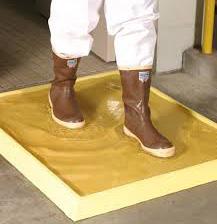
3 minute read
Biosecurity Article
BIOSECURITY MEASURES FOR YOUR RABBITRY
BY CHERYL LOESCH
We’ve all heard that the Rabbit Hemorrhagic Disease virus 2 (RHDv2), has hit the Southwestern United States, as well as being considered endemic to the area of Victoria, BC, Washington state where it showed up two years ago. Now RHDv2 has spread to wild populations of rabbits and hares. Though this is the first time we have seen the disease spread into wild populations, it does not necessarily mean the virus has mutated, but that it has now been observed and tested in those populations. What this does mean for us is that there are more vectors for the virus to transmit more rapidly. We know that the virus is “non-enveloped,” or does not have a fatty protein barrier around it. This means that it can spread more readily, via many sources, and this is why some refer to RHD as a “sticky” virus. RHD Spreads by via oral, nasal, conjunctival cavity contacts with the virus from: • Fomites (clothes, shoes, furniture—anything that’s come in contact with a contaminated source) • Contaminated food/water • Equipment • Flies, vermin, predators • Infected rabbits’ excretions
The virus can be spread by insects and predators that have eaten or had contact with infected animals. Any pest that has come in contact with a source of infection can spread the virus wherever they go. You can spread the virus on your clothes, hands, shoes, car tires, etc. There is a vaccination, however, it is not readily available as yet.
Our best protection against RHDv2 is to take biosecurity measures to protect our rabbits and rabbitries. This boils down to 3 basic steps: Control, Close, Clean.
Control what comes into your rabbitry: pests, feed sources, germs. Your best defense is to keep out things that might contaminate your animals. Screen your windows and doors and/ or use other insect control measures. Find and plug holes that could allow rodents or other predators into your rabbitry. If you keep a cat for handling mice in your rabbitry, you may need to either keep that cat entirely inside, or entirely outside of your rabbitry, so that it cannot track virus particles back into the rabbitry. Keep food in pest-proof containers, and consider stopping any forage feeds that you cannot guarantee are free of contaminants. Do not share equipment. This means grooming tools, grooming mats and tables, cages, etc.
Close your rabbitry to outsiders. No people in or out who don’t need to be there for animal care. Quarantine new animals, or animals returning from shows for at least 30 days, and care for those animals after you’ve cared for all others. Don’t allow your rabbits outside of your rabbitry, except for travel that must be undertaken, and then quarantine them upon return.
Clean and disinfect your rabbitry, equipment, and your clothes frequently. Clean first, to remove any organic matter (wool, feces), then use a disinfectant that will kill the virus (see below). Remember that disinfecting requires cleaning first—disinfectants are generally deactivated by organic matter. Most disinfectants need to stand for 10 minutes before being rinsed off. Use a footbath or disinfectant foot mat at the entrance to your rabbitry. Wear clothes and shoes or boots dedicated just to your rabbitry, and clean them immediately upon finishing your chores. The importance of washing your hands before and after handling your rabbits, and between handling rabbit groups (non-quarantined and quarantined) cannot be understated.
Because RHDV is a calicivirus, it lacks the fatty envelope that most viruses have, its infectivity is NOT reduced by ether or chloroform and trypsin or quaternary ammonium compounds. What disinfecting agents will kill the RHDv2 virus? You can use the following in your disinfectant sprays and footbaths:
The RHD calicivirus is inactivated by sodium hydroxide (1%) or formalin (1-2%), as well as 1.0–1.4% formaldehyde or 0.2–0.5% beta-propiolactone at 4C (39F). Chlorine dioxide at 10 ppm concentration also kills this virus.
Other suggested disinfectants include: sodium hypochlorite (1:10 dilution household bleach), substituted phenolics, such as 2% One-stroke Environ® (Vestal Lab Inc., St. Louis, MO), and potassium peroxymonosulfate (e.g. 1% Virkon-S® by DuPont).
Finally, establish a relationship with a veterinarian. Exotics or livestock vets are probably our best sources for medications, and for the RHD vaccines, when they become available.











